Issue #75, Volume #2


Just Buy Businesses That Are “Inevitable”
This is Porter’s Daily Journal, a free e-letter from Porter & Co. that provides unfiltered insights on markets, the economy, and life to help readers become better investors. It includes weekday editions and two weekend editions… and is free to all subscribers.
Editor’s note: Last Friday, Porter discussed his personal portfolio’s outstanding performance this year, up 54%. Porter calls this approach to investing a “Birthright Trust.” It uses the non-correlated, low-volatility structure of a “permanent portfolio” and includes substantial leverage to produce market-beating results. He’s sending a video to our Partner Pass members on Friday to show members exactly how to do this, using his own personal portfolio as a template. And, in preparation for this, Porter is discussing the three most important principles of great investing. Below is Part II: Never lose money.
| Mark Twain was not a good investor… Porter’s greatest investing mistake… Never lose money… All they need is for cockroaches to continue to survive… If you won’t own it for 10 years, don’t even own it for 10 minutes… Another sign consumers are running out of money… |
Mark Twain wasn’t just a great American writer. He was the first, major media powerhouse in American history.
A famed author, Samuel Clemens launched his own publishing company in partnership with his nephew, Charles L. Webster. Their first book was Twain’s great work: Adventures of Huckleberry Finn.
Beyond the literary accomplishment, Charles L. Webster And Company pioneered a new publishing business model: direct door-to-door sales. Back then (the book was published in 1885) bookstores were rare – almost non-existent. Most books were published as serials in magazines. But Clemens was so-well known as America’s best author, the company was able to employ 10,000 salesmen to sell the book across the country. The hardcover cost $2.75, and buyers were allowed to pay for it via a subscription over time, if they couldn’t afford the single payment.
The result was a huge financial windfall: they sold 150,000 copies over the next decade, generating almost half a million dollars in revenue (~$20 million in today’s dollars). And that success enabled Clemens to win the publishing rights to America’s best-selling book of all time (up to that point) Personal Memoirs of U.S. Grant by Ulysses S. Grant. In 1886 the book sold over 400,000 copies at prices up to $9 a copy. It generated over $1 million (~$40 million in today’s dollars) and launched the company’s successful “general’s series,” which included memoirs by several of the Civil War’s most notable leaders.
The success of the business propelled Clemens into the ranks of America’s wealthiest people, part of the “Rockefeller set,” as he put it. He bought a large estate outside of Hartford, Connecticut,and employed a large staff. Had Clemens made even marginally productive investments (this was an age of tremendous technological advancement), he could have built a substantial fortune with the publishing company’s cash flows.
But that’s not what happened.
Instead, he famously filed for bankruptcy in 1894.
Clemens was among the worst investors in history. His incredible imagination – his greatest attribute as a writer – was his Achilles’s heel as an investor. Again and again, Clemens made big investments because he could imagine a positive outcome, while ignoring the very real downside risks.
He had many smaller failures. Then he lost his entire fortune by investing, for over a decade, in the Paige Compositor – this was an incredibly complex new machine designed to automate typesetting, in the printing of books and magazines. Between 1880 and 1894, Clemens invested around $200,000 (~$10 million in today’s dollars) into this highly risky venture. He publicly proclaimed the future success of the machine, drew his family and friends into the venture… and… it never worked. Year after year, the machine failed. And then it was rendered obsolete by a different new technology, the Linotype machine.
The late Charlie Munger liked to say, “Just tell me where I’m going to die, so I won’t go there.”
As a writer and a publisher, I think about Clemens’ failure as an investor all the time. I’ve strived to avoid a similar fate… but, boy, it was close!
I’ve made a lot of similar errors. I loved to invest in new technology that promised to upend the world. I bought Amazon (AMZN) in 1997 – among many other high-tech investments. And, at various points in my life, I’ve made very risky investments into biotech too.
My worst investment ever? Like Clemens, I single-handedly backed the development of a very high-tech, new machine: a men’s razor that pioneered using ultra-high-quality steel and the latest in computerized design to deliver a superior shave. The OneBlade razor is an amazing and beautiful tool, but what I discovered over a decade of investing in the business was that shaving is a marketing contest, not a contest of design and steel.
Today, I’ve completely changed my strategy. I’m building a “Birthright Trust.”
Rather than looking for home run investments, I’m focusing on can’t fail investments. These are “inevitable” businesses, where I can invest huge amounts of capital, safely.
Not many people know the story of the Rollins brothers, but they created one of the world’s largest fortunes… with a single investment. Luckily for me, for decades my uncle was a close associate of the Rollins family.
In 1964, the Rollins brothers executed one of the very first leveraged buyouts in American history. Rollins Broadcasting, then with $9.1 million in annual revenue and only $900,000 in net income, acquired Orkin Exterminating Company, a nationwide pest-control firm with $37.3 million in revenue and $3 million in net income.
How’d they get the deal done? They offered $62.4 million!
How’d they afford it? They used other people’s money, mostly a $40 million loan from Prudential Insurance.
How’d they possibly figure all of this out and pull it off? The real architect of the deal was Lewis Cullman, who ran his family’s investment firm. The Cullmans, you may recall from our work on Philip Morris International (PM), made their fortune in tobacco. Lewis was the brother of Philip Morris’ legendary CEO Joe Cullman, who created the modern Marlboro brand.
These investors had a clear vision: The Cullmans were trying to find an asset they knew, beyond any doubt, would continue to compound at very attractive rates – forever. They knew demand for pest control, especially by corporate clients, was non-cyclical. And they also knew that by owning the best brand in that industry (Orkin) it was very unlikely that any competitor would be able to unseat them.
Look at Rollins stock chart and you’ll see how right they were.
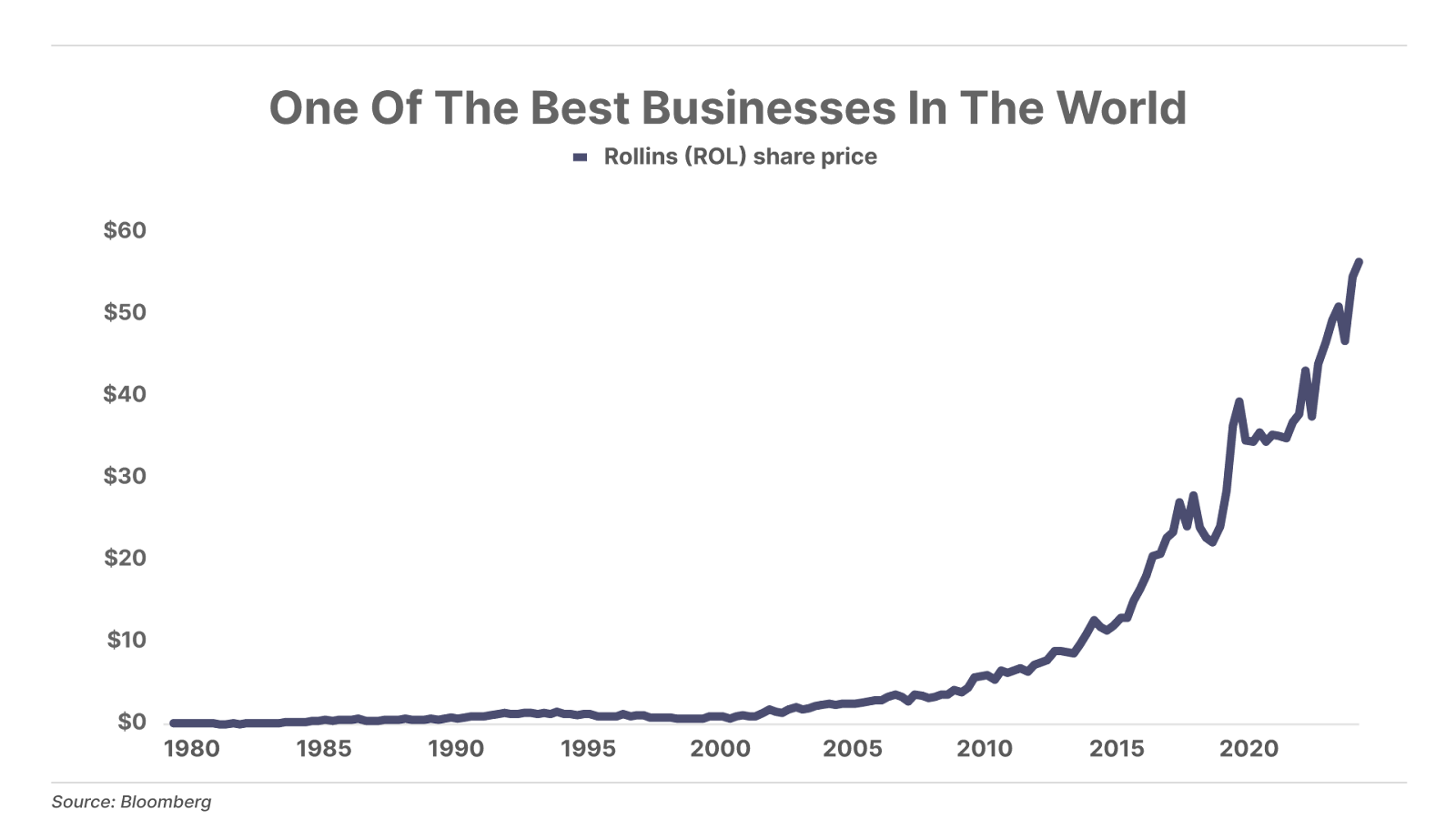
Even now, more than 60 years (!) since that deal, Rollins is still one of the best businesses in the world. The stock is up more than 350% over the last decade. It is still producing annual returns on equity of more than 30%. And today, because investors recognize it as a battleship business, it trades at more than 50x earnings.
Do you think Rollins owners care about the future of the dollar, or tariffs, or about whether there’s a recession next year? Not at all. All they need is for cockroaches to continue to survive. And that’s a pretty safe bet.
Remember what Warren Buffett said about how to make investments? Look for “inevitables.”
We are searching for operations that we believe are virtually certain to possess enormous competitive strength 10 or 20 years from now. Your goal as an investor should simply be to purchase, at a rational price, a part interest in an easily-understandable business whose earnings are virtually certain to be materially higher five, 10, and 20 years from now. Over time, you will find only a few companies that meet these standards – so when you see one that qualifies, you should buy a meaningful amount of stock. You must also resist the temptation to stray from your guidelines: If you aren’t willing to own a stock for 10 years, don’t even think about owning it for 10 minutes. Put together a portfolio of companies whose aggregate earnings march upward over the years, and so also will the portfolio’s market value.”
— The Letters of Warren Buffett, 1996
As Buffett explained, again and again, the #1 rule is: don’t lose money.
You can avoid losing money by only buying these kinds of “inevitable” businesses that are virtually certain to continue growing for decades. And if you’re willing to do so, just like Buffett (with insurance float) and just like the Rollins brothers (with long-term debt financing) you can safely use other people’s money.
That “leverage” is what will drive your excess returns, not anything spectacular from your portfolio.
The ironic part of this is, when you focus on only owning great businesses for the long term, you’re likely to far outperform the market even without using leverage.
More than a decade ago, while I was still at Stansberry Research, I commissioned a major research study in trying to prove this. We studied what happened over the long term if you only invested in companies that:
- Owned one or more great brands
- Were highly profitable (operating margin above 15%)
- Had stable ownership: 20% less volatile than the S&P 500
- Were capital efficient
- Were consistently growing revenue
And, in our study, investors only bought these stocks if they were trading at a “good” price – less than 12x earnings.
Seems pretty simple, right? Buy great businesses when they’re trading at a good price.
Following this strategy created portfolios that beat the S&P 500 by a huge amount, 750 basis points (7.5%) a year on average.
The best part? There were only a handful of stocks to look at each year to follow this strategy. In one year, there were only four stocks to buy. And because of the huge rally in stocks, right now there’s only one stock that fits all of the criteria: Pfizer (PFE).
But several other well-known, high-quality businesses are close, including: Alibaba (BABA), Alphabet (GOOG), AutoZone (AZO), Brown-Forman (BF), eBay (EBAY), Fox (FOX), The Hershey Company (HSY), Inditex (IDEXY), Johnson & Johnson (JNJ), Kimberly-Clark (KMB), Nestle (NSRGY), PepsiCo (PEP), and Unilever (UL).
On Friday, I’ll send a video to our Partner Pass members showing exactly how I’ve used these ideas to build my own Birthright Trust. I’ll walk Partners through each step of how I built the portfolio, why I picked the securities I did, how the various parts of the portfolio offset each other to limit volatility, and how I utilized margin to scale my returns. My hope is that this will help guide you to building a similar, permanent approach to investing.
If you’re interested in becoming a Partner Pass member and getting access to the video I send on Friday and everything else that we at Porter & Co. publish, please call us this week – before we shut down for the holiday weekend: 844-933-9986.
Three Things To Know Before We Go…
1. More signs of consumer stress. U.S. consumer spending on services dropped to the lowest level in over three years in May, continuing a downward trend that has persisted throughout 2025. Since the service sector of the U.S. economy should be immune from rising tariff rates, this data series reveals a consumer weakness that can’t be explained away by trade disruptions.
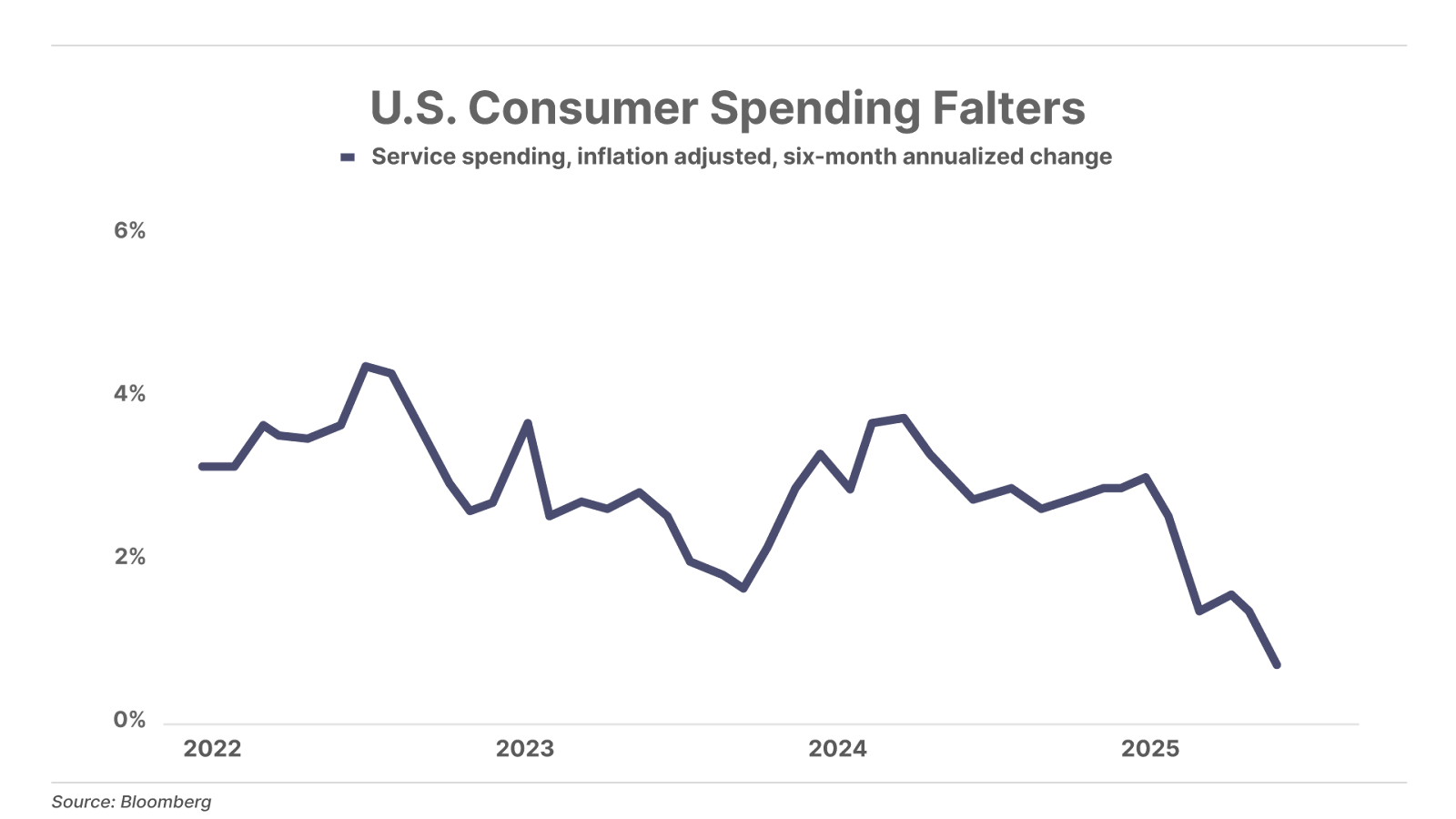
2. Liquidity tells a different story. Despite weak consumer spending, the S&P 500 just hit an all-time high – nearly reaching 6,200. A key driver behind this rally has been robust liquidity: as more money enters the system, more capital flows into equities, fueling further gains. Based on current M2 money-supply levels, the S&P 500 is well-positioned to reach 6,800 later this year. However, should the money supply stop increasing, both consumers and the stock market could lose steam. For now, there appears to be no end in sight to monetary expansion.
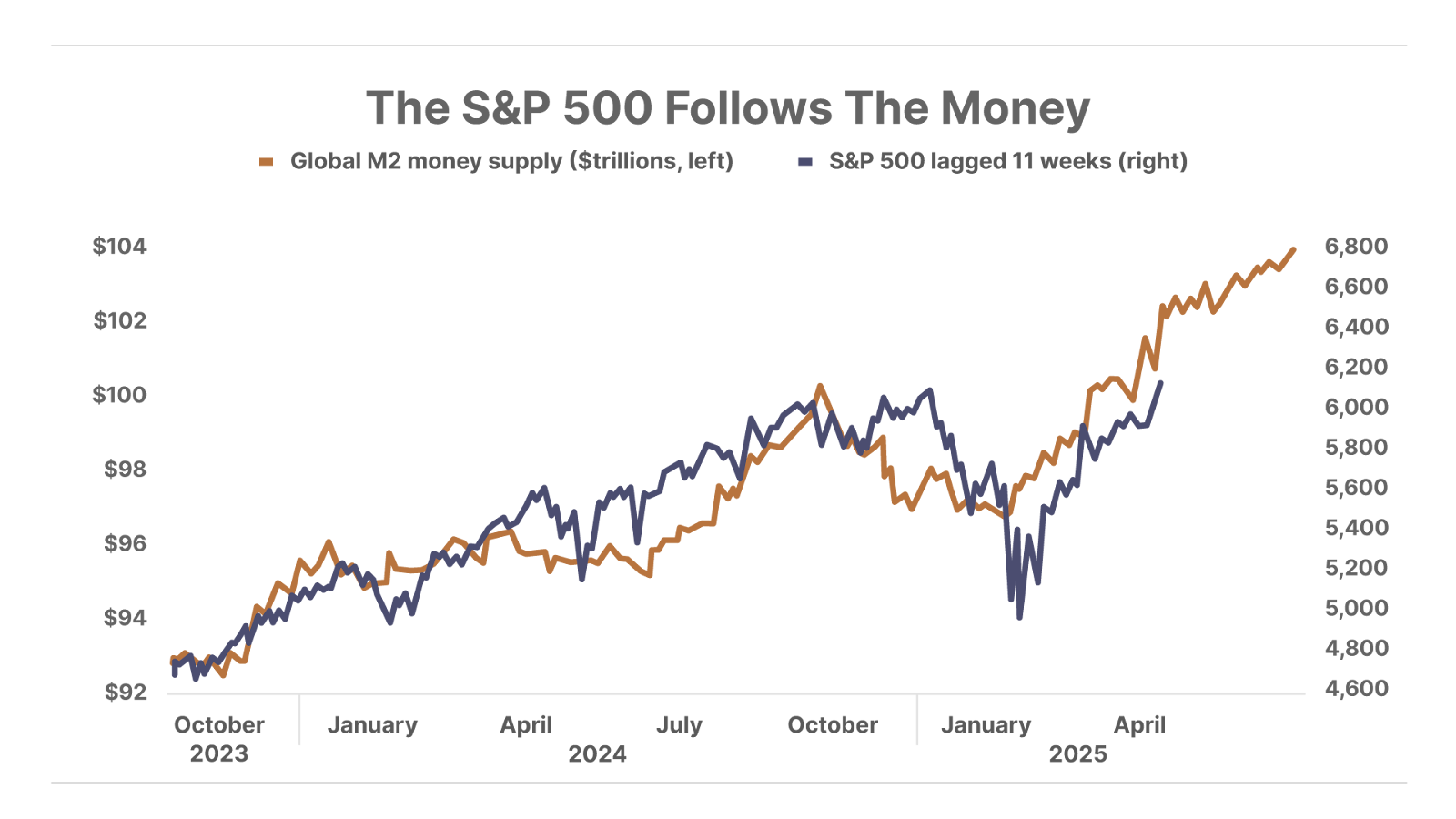
3. Tokenized equities are here. This morning, Robinhood Markets (HOOD) became the first major brokerage firm to offer tokenized versions of more than 200 U.S. stocks and exchange-traded funds (“ETFs”) for its customers in the European Union. Tokenization utilizes blockchain technology to create digital versions of assets that can be traded 24 hours a day with instant transactions. The company plans to expand to thousands of stocks by the end of the year, including stocks of privately held companies such as Sam Altman’s OpenAI and Elon Musk’s SpaceX. As Robinhood CEO Vlad Tenev noted, this move is part of an effort to “lay the groundwork for crypto to become the backbone of the global financial system.”
Ticker-Reveal For Exposure To Elon’s Next Company
Discover what Elon’s working on in a special event for Porter & Co. readers…Plus, get the backdoor ticker giving investors early exposure — before the IPO — simply for watching.
And One More Thing… Investing With Leverage
In today’s Journal, Porter revealed that he will be sharing with Partner Pass members a video in which he explains, step by step, how he built his own portfolio, why he picked the securities that he did, and how he utilized margin, or leverage, to scale his returns.
Tell me what you think: [email protected]
Mailbag
Those of us who cannot afford the Partner Pass membership are the ones who need your help the most.
I lost my job a year ago and am still trying to secure a new position. However, with rent and everyday living expenses, there is little left to invest, let alone purchase additional services. I plan to continue watching your videos and reading your emails, with the hope of learning as much as possible to one day achieve success in increasing my portfolio.
Jean T.”
Porter’s comment: Jean —
It is an iron law: you have to have capital to invest it. Otherwise known as: it takes money to make money.
I have sympathy for your situation. I’ve been there myself. And I think you’ll find that our free content contains an enormous amount of good ideas that can help you.
I found you years ago and became a Stansberry Research Alliance member, and then you did it all over again and invited me in to become a Partner Pass member. The education and advice have been priceless and along with that there has been some life education that has been most helpful. I am wishing you a long, healthy, happy life for you and the family so I can keep reading your letters for years to come. Thank you.
Neil S.”
Good investing,
Porter Stansberry
Stevenson, Maryland
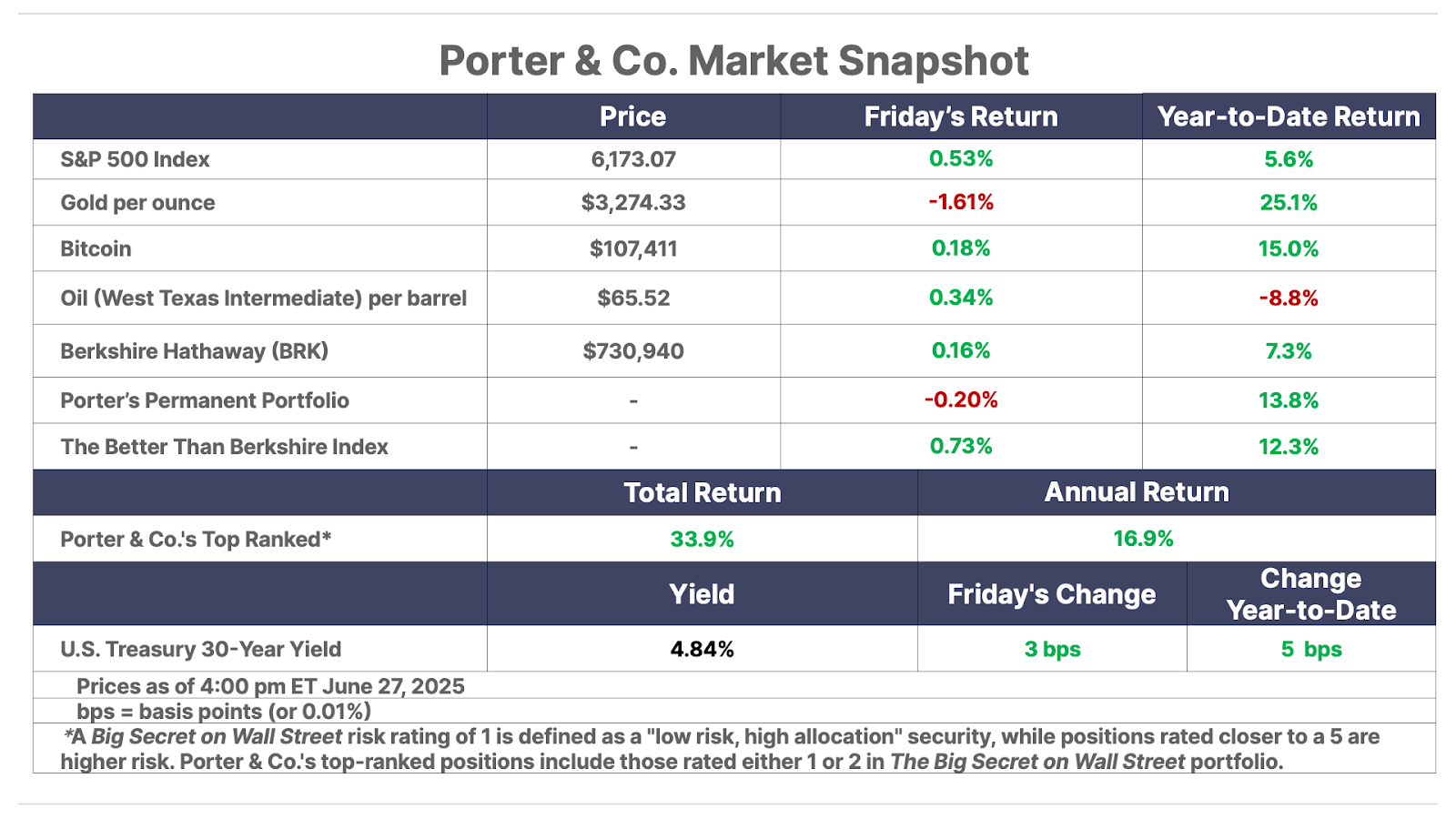
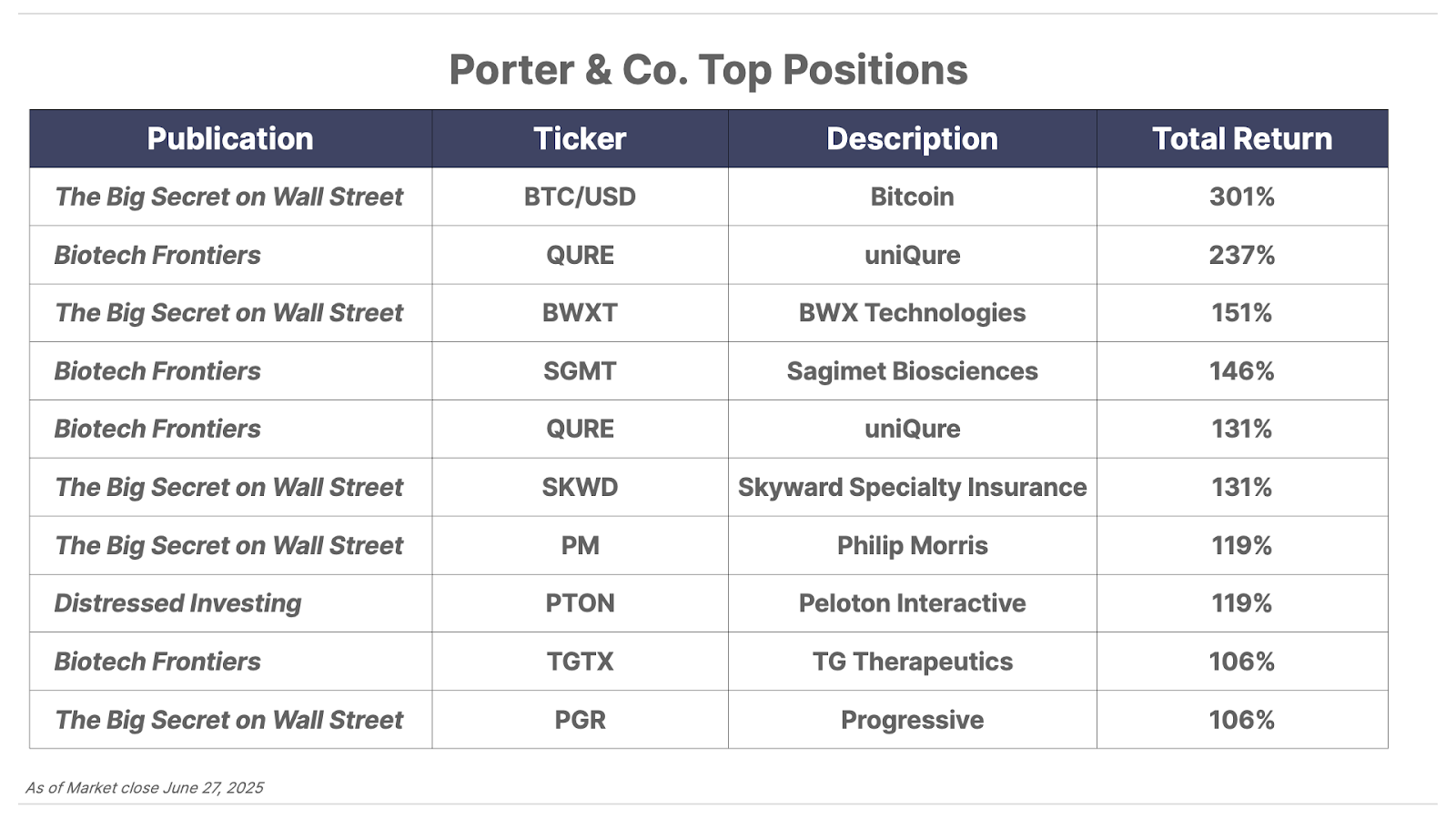
Please note: The investments in our “Porter & Co. Top Positions” should not be considered current recommendations. These positions are the best performers across our publications – and the securities listed may (or may not) be above the current buy-up-to price. To learn more, visit the current portfolio page of the relevant service, here. To gain access or to learn more about our current portfolios, call Lance James, our Director of Customer Care, at 888-610-8895 or internationally at +1 443-815-4447.
